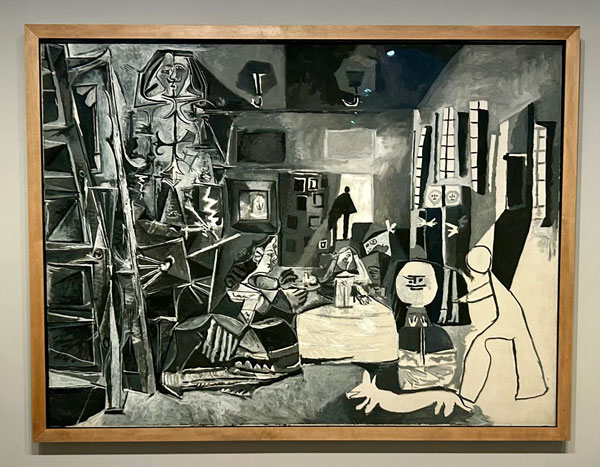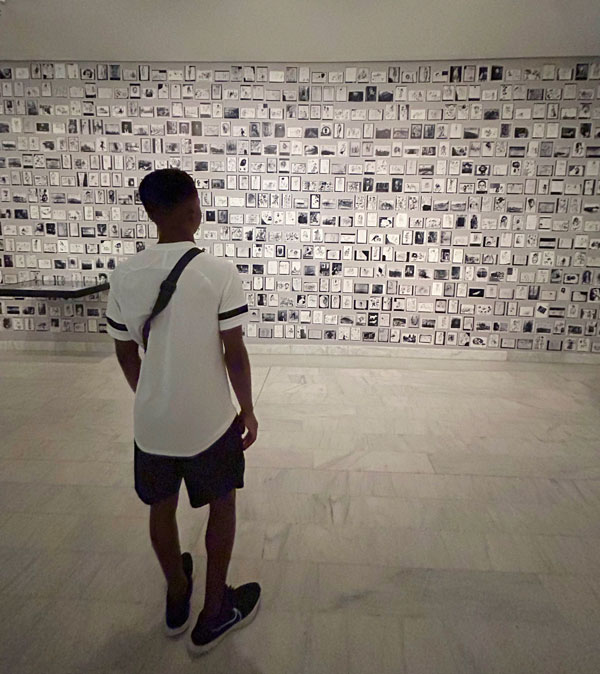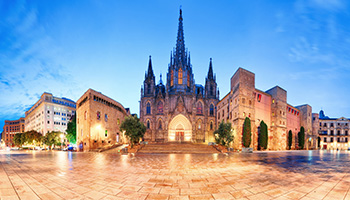Pondering Picasso while Studying Abroad in Barcelona, Spain

A banner located at the Picasso Museum entrance recognizing the 50th anniversary of the icon’s death).
Growing up, I wasn’t much of a museum buff. I’d likely only be in and around museums if they were part of a school field trip. It’s not because I didn’t enjoy them, I simply never took it upon myself to venture into the unknown and connect with art on a personal level. Until I felt connected to art while studying abroad.
Studying abroad in Barcelona meant I was only a few metro stops away from the Museu Picasso (or, the Picasso Museum). One of my study abroad goals was to immerse myself in Spanish culture, and artistic expression is an important part of that. As an avid poetry writer, I appreciate how certain ideas are abstract but still somehow deeply resonate with all who engage with them. It was that “aha” moment that I was eager to experience. I journeyed to the quaint neighborhood of El Born with my roommates Bobby, Josh, and Kian on a Saturday afternoon — and I discovered the power of observing and commenting on art with them.
First Impressions

Yours truly enjoying the experience.
Walking into the museum, I immediately found myself surrounded by breathtaking paintings and sculptures. It quickly dawned on me that I was in a museum housing the works of one of the greatest artists ever. I noticed that I gravitated towards works that were more complex, more meaningful than how they appeared on the surface. And one of such pieces was ‘‘The Maids of Honor.’’

‘‘Las Meninas’’ (‘‘The Maids of Honor’’) at the Picasso Museum in Barcelona.
When I first saw it, I asked myself how Picasso combined a certain level of abstractness with realism. Because even though faces and objects didn’t look like they do normally, he depicted certain emotions and objects in a way that’s intuitive for us. Picasso’s subtle, yet powerful artistic choices add layers of mystery, and I wondered what his intention behind the piece was. After doing a bit of digging online, I learned that the painting is Picasso’s reinterpretation of an original work also called ‘‘Las Meninas’’ (‘‘The Maids of Honor’’) by fellow Spanish artist Diego Velázquez. Velázquez’s purpose was to offer a glimpse into the Spanish royal court during Philip IV’s reign. He presented what was a typical scenario: Infanta Margarita Teresa of Spain, the king’s daughter, being attended to by maids. While Picasso also included her in the frame, he depicted Velázquez as a towering figure, thereby making him the central figure in his piece — an indication as to how much Picasso admired him.
As I moved away from ‘‘Las Meninas,” I observed other pieces and pondered Picasso’s possible thought processes as he expressed himself. It also proved meaningful reading about the time periods when certain works were made and how he began experimenting with new artforms.

Deep in thought while observing Picasso’s works.
Glimpses Into Picasso’s Mind
We might assume that Picasso, being the exceptional artist that he was, was familiar with and skilled at working with clay. But it was only at the age of 64, at the Madoura ceramics workshop on the French Riviera, that he first engaged with the material. I was amazed to learn how from that moment onwards he invested a remarkable amount of time and energy in bringing to life his newfound passion for ceramics. ‘‘The enormous interest and curiosity that this ancient art of fire aroused in him made him want to learn its secrets and, above all, include it in his work as another artistic medium,’’ an exhibition label read.

Pablo Picasso ceramic plate.
It was interesting to learn the history behind Picasso’s artistic periods and to contextualize them based on different social and political climates. His works often reflect his personal life, and in some ways, it was as if Picasso himself was a canvas on which he allowed life’s circumstances to paint, or clay that he granted life permission to mold.
As I strolled through different corners of the museum, and gazed at his masterpieces, I couldn’t help but wonder what was going through his mind with each stroke of a brush and each mark of a pencil. I was, and still am, intrigued by how the work he created has the power to elicit various emotions in viewers — joy, sadness, awe, amusement, you name them. And I certainly wasn’t the only one.

My roommates, Bobby and Josh.
Experiencing Art Vicariously
From my roommates to other visitors, there was a palpable silence as people observed Picasso’s works. I sensed that they were mesmerized by his pieces as they’d often gesture to them and, I imagine, talk about what it meant and maybe how it all made them feel. I think we can learn a lot just by observing what makes others stop in their tracks. We can try to pay attention to which paintings make visitors smile, think, or snap a picture. Because they might be clues as to what’s worth paying attention to, and we might even see if the artist’s intentions align with people’s emotional responses. Just remember to stare at the art, not the observers!
Bidding Farewell to the Museum — But Not To Artistic Expression and Thought

My roommates, Kian and Josh, roaming the streets moments after we leave the Picasso Museum.
As my roommates and I made our way out, we left feeling more informed about Picasso, the historical and personal events that shaped his life and, of course, his art. But if we thought our sights of creativity that day were over, we were very, very wrong. Among other awe-inspiring graffiti, we saw a stunning Lionel Messi mural in El Born as we walked to the Jaume I metro station to make our way back home. Featuring colors reminiscent of FC Barcelona, which brought back amazing memories, the art abroad looked so realistic and combined different elements of the soccer legend’s background and career. I wouldn’t be surprised if the mural artist Gaston Liberto, and others who infused vibrancy into the streets, drew inspiration from Picasso, the icon himself.

A Lionel Messi Mural in El Born.












